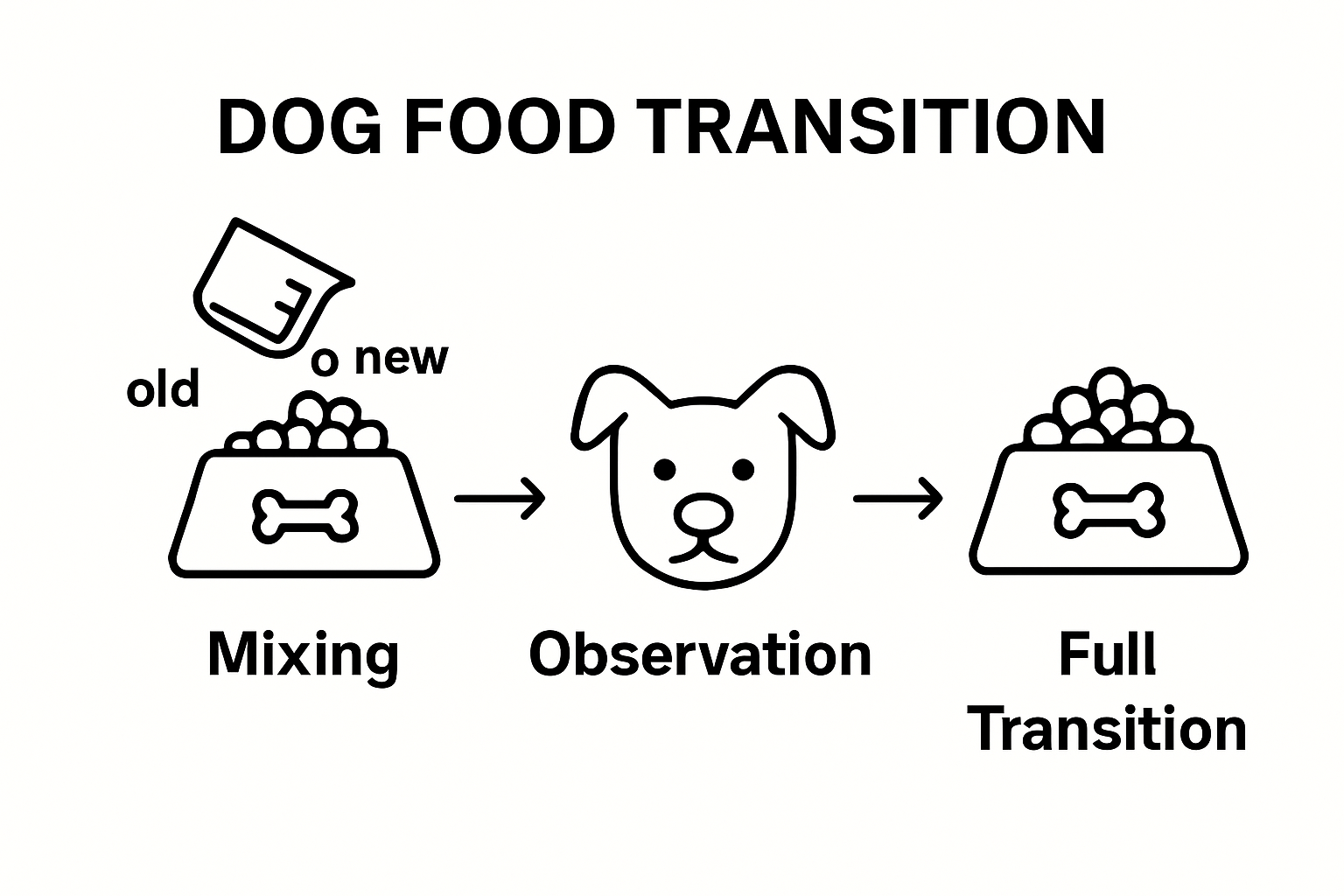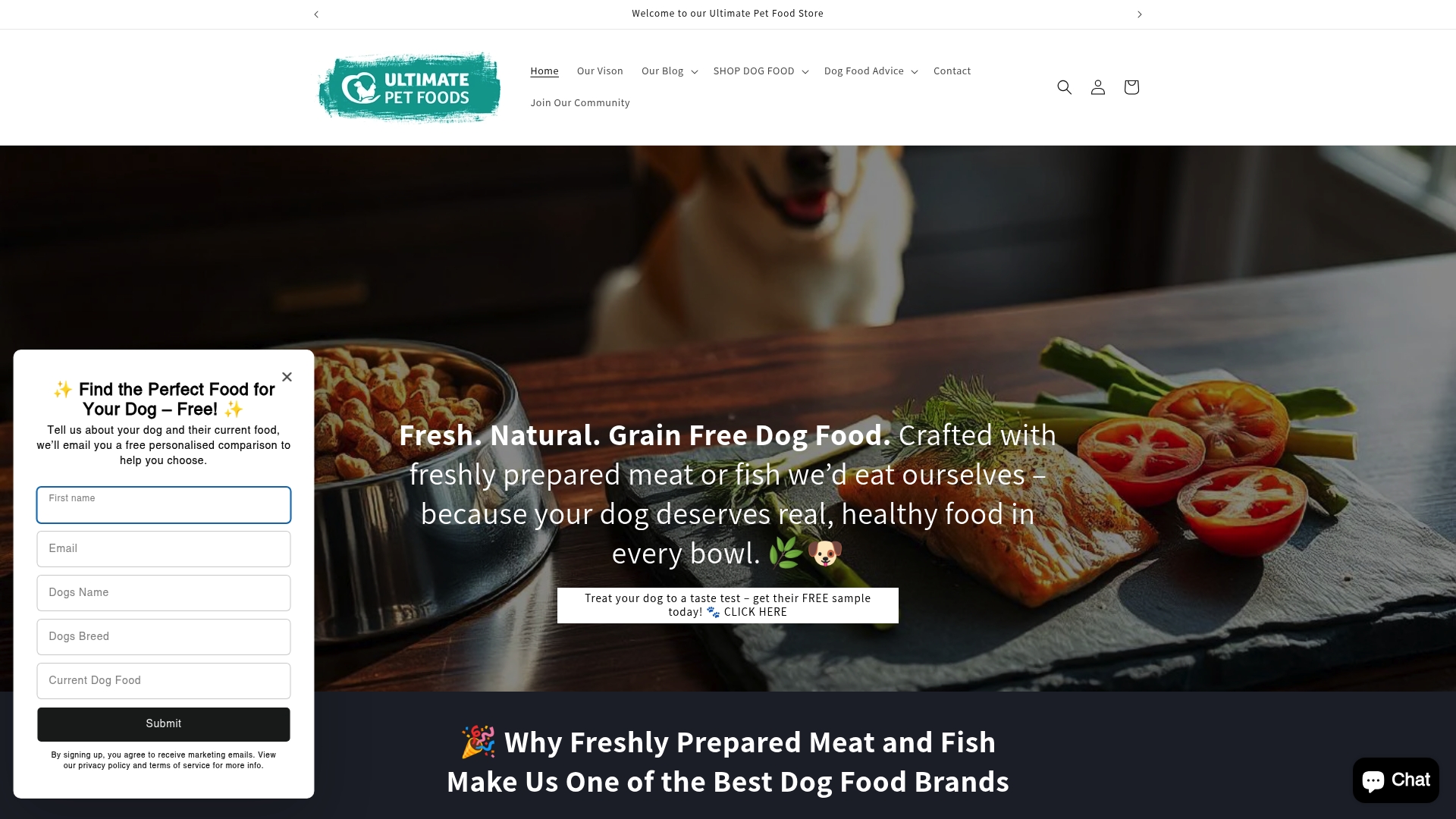
How to Choose Dog Food: A Step-by-Step Guide for Healthy Dogs
Share
Choosing the right dog food is more than a matter of taste. It shapes your pet’s health, energy, and happiness day after day. Yet most owners are surprised when they learn that a dog’s nutritional needs can shift drastically with something as simple as age or a change in activity levels. Forget those one-size-fits-all solutions. The reality is, finding the best food starts with understanding your dog’s unique profile and being ready to adjust as their needs evolve.
Table of Contents
- Step 1: Evaluate Your Dog’s Specific Nutritional Needs
- Step 2: Research Natural and Grain-Free Options
- Step 3: Read Labels for Ingredient Quality and Source
- Step 4: Consult Your Vet for Professional Advice
- Step 5: Test Different Food Types Gradually
- Step 6: Monitor Your Dog’s Health and Adjust as Needed
Quick Summary
| Key Point | Explanation |
|---|---|
| 1. Evaluate Your Dog’s Nutritional Needs | Assess your dog’s age, breed, weight, and health to determine their unique dietary requirements. |
| 2. Research Natural and Grain-Free Foods | Focus on food with whole ingredients and avoid artificial additives to mimic a dog’s ancestral diet. |
| 3. Read Labels for Quality Ingredients | Prioritise foods with named meat sources and avoid vague terms and fillers for optimal nutrition. |
| 4. Consult Your Vet for Tailored Advice | Take detailed health information to your vet for professional recommendations based on your dog’s needs. |
| 5. Monitor Health and Adjust Diet | Track your dog’s condition and make necessary dietary changes based on their health and behaviour. |
Step 1: Evaluate Your Dog’s Specific Nutritional Needs
Understanding your dog’s unique nutritional requirements is the foundational step in selecting the perfect dog food. Every dog is different, with nutritional needs varying based on age, breed, weight, activity level, and overall health status. These individual factors significantly influence the type and quantity of food your furry companion requires.
Start by closely examining your dog’s current health profile. Puppies, adult dogs, and senior canines have dramatically different nutritional demands. A young, energetic border collie will need a protein-rich diet supporting high activity levels, while an older, less mobile companion might require fewer calories and more joint-supporting nutrients. Weight plays a crucial role too - an overweight dog needs a carefully calibrated diet to support gradual, healthy weight loss.
Consult with your veterinarian to conduct a comprehensive health assessment. They can provide detailed insights into your dog’s specific requirements, including potential allergies, sensitivities, or underlying health conditions that might necessitate a specialised diet. For instance, dogs with skin conditions might benefit from foods rich in omega fatty acids, while those with digestive issues could require highly digestible protein sources. Our guide on reading dog food ingredients can help you understand what to look for on nutrition labels.
Key evaluation factors include:
- Current body condition and ideal weight
- Activity level and exercise routine
- Age and life stage
- Breed-specific nutritional needs
- Any existing health conditions or allergies
Successful nutritional evaluation means identifying a diet that supports your dog’s optimal health, maintains an ideal body weight, provides balanced energy, and contributes to long-term wellness. By taking a thoughtful, personalised approach to your dog’s nutrition, you’re laying the groundwork for a healthier, happier companion.
Step 2: Research Natural and Grain-Free Options
Researching natural and grain-free dog food options represents a critical step in selecting the most appropriate nutrition for your canine companion. Modern pet nutrition has evolved significantly, with increasing awareness about the potential benefits of minimally processed, whole-ingredient diets that mimic dogs’ ancestral eating patterns.
Begin your research by understanding what truly defines natural and grain-free dog food. Natural dog food typically means ingredients sourced from whole food sources without artificial preservatives, colours, or synthetic additives. Grain-free options eliminate traditional grains like wheat, corn, and rice, often replacing them with alternative carbohydrate sources such as sweet potatoes, peas, or legumes. These diets aim to provide nutrition closer to what dogs might have consumed in their evolutionary history.
Carefully examine ingredient lists and nutritional profiles. Look for foods that list real meat as the first ingredient, indicating high-quality protein sources. Pay attention to protein content, ensuring it meets your dog’s specific metabolic needs. Freshly prepared meats provide superior nutrition compared to heavily processed meat meals. Some dogs with sensitive digestive systems or allergies might benefit significantly from grain-free options that reduce potential inflammatory responses. Check out our guide on ingredients to avoid in dog food to make more informed choices.
Key considerations during your research include:
- Protein source quality and variety
- Absence of artificial preservatives
- Balanced nutrient profile
- Compatibility with your dog’s specific health requirements
- Digestibility of alternative carbohydrate sources
Successful research means finding a natural, grain-free diet that provides complete nutrition, supports your dog’s health, and aligns with their individual dietary needs. By investing time in understanding these nutritional options, you’re taking a proactive approach to your dog’s long-term wellness and vitality.
Below is a summary table comparing natural and grain-free dog food options to help clarify definitions and key considerations discussed in this section.
| Option | Definition | Key Features | Typical Carbohydrate Sources |
|---|---|---|---|
| Natural Dog Food | Uses whole food ingredients, avoiding artificial preservatives, colours, and synthetic additives | Real meat as first ingredient, balanced nutrition, no artificial substances | Grains (wheat, rice), potatoes |
| Grain-Free Dog Food | Omits traditional grains and uses alternative carbohydrate sources | Grain alternatives, supports allergy/sensitivity needs, high protein focus | Sweet potato, peas, legumes |
Step 3: Read Labels for Ingredient Quality and Source
Reading dog food labels is an essential skill that empowers pet owners to make informed nutritional choices. Labels provide a comprehensive snapshot of the food’s composition, revealing critical details about ingredient quality, nutritional balance, and potential health implications for your canine companion.
When examining a dog food label, focus first on the ingredient list. Ingredients are listed in descending order by weight, which means the first few items represent the primary components of the food. Whole meat sources like chicken, lamb, or fish should appear at the top, indicating high-quality protein content. Be cautious of vague descriptions like “meat meal” or “by-products,” which often signify lower-quality protein sources. Avoid foods with unnamed meat sources or excessive grain fillers that provide minimal nutritional value.
Understand the difference between primary and secondary ingredients. While meat should lead the list, pay attention to subsequent components like vegetables, fruits, and supplementary nutrients. Look for named whole food sources rather than generic terms. Complex carbohydrates, omega fatty acids, and natural preservatives contribute to a balanced diet. Some dogs might require specific ingredient profiles based on their health conditions or breed characteristics. Learn more about dog foods to avoid for optimal health to refine your selection process.
Critical label reading indicators include:
-
Presence of named, whole meat protein sources
-
Absence of artificial preservatives and fillers
-
Clear, transparent ingredient descriptions
-
Nutritional adequacy statements
-
Specific nutritional breakdown percentages
Successful label reading means identifying a dog food that provides transparent, high-quality ingredients tailored to your dog’s unique nutritional needs. By developing this skill, you become an advocate for your dog’s dietary health, ensuring they receive optimal nutrition with every meal.
Step 4: Consult Your Vet for Professional Advice
Consulting your veterinarian is a crucial step in selecting the most appropriate dog food, transforming a potentially overwhelming decision into a targeted, scientifically-informed choice. Veterinarians possess comprehensive insights into your dog’s unique health profile, dietary requirements, and potential nutritional challenges that might not be immediately apparent to pet owners.
Schedule a dedicated nutrition consultation with your veterinarian, bringing comprehensive details about your dog’s current diet, health history, and any observed symptoms or concerns. Prepare a detailed record of your dog’s age, weight, breed, activity level, and any existing health conditions. This information enables your vet to provide precise dietary recommendations. Discuss any recent changes in your dog’s behaviour, energy levels, coat condition, or digestive health, as these can signal underlying nutritional deficiencies or sensitivities that require specialized dietary interventions.
Your veterinarian can offer tailored advice about specific nutritional needs based on your dog’s individual health profile. Some dogs might require specialized diets addressing conditions like allergies, joint problems, weight management, or breed-specific metabolic challenges. They can recommend precise protein levels, identify potential ingredient sensitivities, and suggest optimal nutritional strategies that support your dog’s long-term wellness. Learn more about finding the best food for sensitive dogs to complement your veterinary consultation.
Key discussion points during your veterinary consultation include:
- Current health status and medical history
- Breed-specific nutritional requirements
- Potential food allergies or sensitivities
- Recommended protein and nutrient ratios
- Weight management strategies
Successful veterinary consultation means developing a comprehensive, personalized nutrition plan that addresses your dog’s specific health needs, ensuring they receive balanced, supportive nutrition tailored precisely to their individual requirements.
Step 5: Test Different Food Types Gradually
Testing different food types gradually is a critical process that allows you to discover the most suitable nutrition for your dog while minimizing digestive disruption and potential health complications. This methodical approach helps identify the ideal diet that supports your dog’s overall health, energy levels, and well-being.
Begin the transition by introducing new food incrementally and systematically. Start with a mixture of 25% new food and 75% current food, carefully monitoring your dog’s reaction. This approach allows your dog’s digestive system to adapt slowly, reducing the risk of gastrointestinal upset, diarrhoea, or other adverse reactions. Observe your dog’s response closely during this initial phase, paying attention to subtle changes in energy, coat condition, stool consistency, and overall demeanour. Gradual introduction is key to successful dietary transitions, preventing potential nutritional shock and allowing your dog’s system to adjust comfortably.
Over a two-week period, progressively increase the proportion of new food while decreasing the old food. Week one might involve 25% new food, week two 50%, week three 75%, and by week four, you should be feeding 100% of the new diet. Check out our expert tips for transitioning dog foods successfully to ensure a smooth dietary change.
 During this process, maintain a detailed journal documenting your dog’s response, including appetite, digestion, energy levels, and any potential allergic reactions or sensitivities.
During this process, maintain a detailed journal documenting your dog’s response, including appetite, digestion, energy levels, and any potential allergic reactions or sensitivities.
Key indicators of successful food transition include:
- Consistent, firm stool quality
- Maintained or improved energy levels
- Healthy, glossy coat condition
- Stable appetite and weight
- No signs of digestive distress
Successful food testing means finding a nutritional approach that not only meets your dog’s dietary requirements but also promotes optimal health, vitality, and happiness. By approaching dietary changes with patience and careful observation, you become an informed advocate for your dog’s nutritional well-being.

Step 6: Monitor Your Dog’s Health and Adjust as Needed
Monitoring your dog’s health after introducing a new diet is a dynamic, ongoing process that requires attentive observation and willingness to make nutritional adjustments. Each dog’s body responds uniquely to dietary changes, making continuous assessment crucial for maintaining optimal health and nutritional balance.
Physical indicators provide the most immediate insights into your dog’s dietary response. Carefully track changes in coat shine, skin condition, energy levels, muscle tone, and overall vitality. A high-quality diet should manifest in a glossy coat, healthy skin, consistent weight, and stable energy throughout the day. Digestive health serves as a critical marker - watch for consistent, firm stools, absence of excessive gas, and comfortable digestion. Unexplained weight loss or gain, lethargy, recurring skin irritations, or digestive irregularities might signal that the current diet requires reassessment. These subtle changes often indicate that your dog’s nutritional needs are not being fully met by the current food selection.
Maintain a comprehensive health journal documenting your observations. Record weight measurements, note any behavioural changes, and track specific health metrics monthly. Your veterinarian can provide professional guidance during regular check-ups, helping validate your observations and recommend precise dietary modifications. Explore our insights on holistic dog nutrition to deepen your understanding of nutritional monitoring. Remember that dogs’ nutritional requirements evolve with age, activity level, and health status, necessitating periodic dietary reviews and potential adjustments.
Use the table below as a checklist to monitor your dog’s health after introducing a new diet, ensuring you track essential indicators for ongoing nutritional wellbeing.
| Health Indicator | What to Look For | Why It Matters |
|---|---|---|
| Body Weight | Consistent, within healthy range | Shows if diet supports ideal weight |
| Coat and Skin | Glossy coat, healthy skin | Reflects nutritional balance |
| Energy Levels | Stable, bright demeanour | Indicates overall vitality |
| Digestive Output | Regular, firm stools | Demonstrates good digestive health |
| Appetite and Behaviour | Normal eating, no lethargy | Signals acceptance and suitability |
Key health monitoring indicators include:
- Consistent, healthy body weight
- Bright, alert demeanour
- Glossy coat and healthy skin
- Regular, firm digestive output
- Stable energy levels
Successful health monitoring means creating a responsive, adaptive nutritional strategy that evolves alongside your dog’s changing physiological needs, ensuring they receive optimal nutrition throughout their life stages.
Your Solution to Stress-Free, Healthy Dog Food Choices
Giving your dog the healthiest start often feels overwhelming. Whether you are worried about ingredients or finding a diet tailored to your dog’s breed and life stage, there is no need to struggle through this alone. If you have a small breed that needs the benefits of a grain free diet or a large breed puppy looking for perfectly balanced nutrition, Grain free small breed dog food and Nutritious & Delicious: Buy Our large breed puppy food Today! are curated with your needs in mind.

It is time to act now for your dog’s well-being. Discover our full premium natural dog food ranges at Ultimate Pet Foods and enjoy peace of mind with every meal. Make the change today and help your dog thrive for years to come.
Frequently Asked Questions
How can I evaluate my dog’s specific nutritional needs?
To evaluate your dog’s nutritional needs, consider factors such as their age, breed, weight, activity level, and any health issues. Consulting with your veterinarian can provide tailored insights based on your dog’s health profile and dietary requirements.
What should I look for in natural and grain-free dog food?
When researching natural and grain-free dog food, check for real meat as the first ingredient, absence of artificial preservatives, and a balanced nutrient profile. Ensure that the carbohydrate sources are digestible and suitable for your dog’s needs.
How do I read dog food labels effectively?
To read dog food labels, focus on the ingredient list, looking for named whole meat sources at the top. Avoid vague terms like “meat meal” or excessive fillers. Understand the nutritional adequacy statements and ingredients to make informed choices for your dog’s diet.
Why is it important to consult my vet before changing my dog’s food?
Consulting your vet is crucial for personalised nutrition advice, especially if your dog has specific health conditions or dietary sensitivities. Your vet can recommend the right balance of nutrients and identify any potential allergies that require attention.
Recommended
- How to Read Dog Food Ingredients: Make Informed Choices – Ultimate Pet Foods
- Expert Tips for Transitioning Dog Foods Successfully – Ultimate Pet Foods
- Understanding Dog Foods to Avoid for Optimal Health – Ultimate Pet Foods
- What Ingredients to Avoid in Dog Food for Healthier Pups – Ultimate Pet Foods
